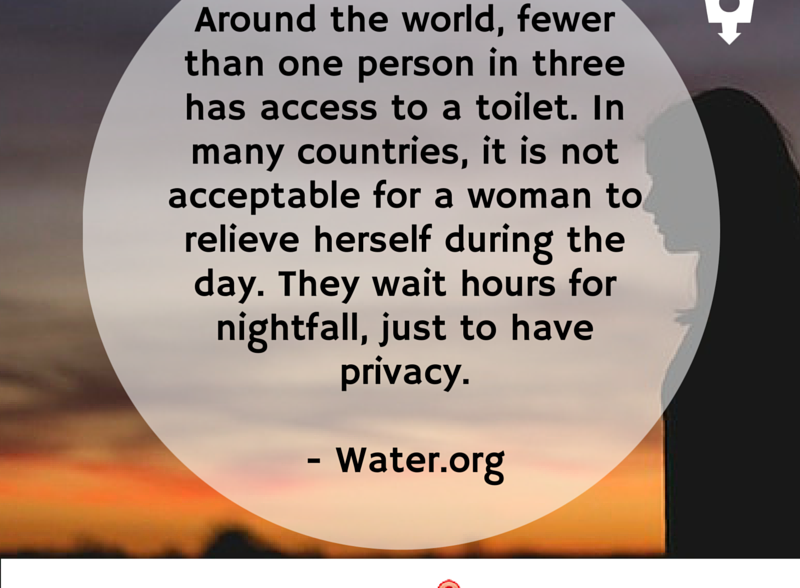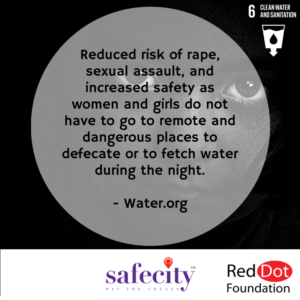Sanitation and Safety- The Co-relation

Sanitation and Safety- The Co-relation
UNICEF (United Nations Child Emergency Fund) reports that about 157 million people in the Eastern and Southern Africa region (ESAR) are not connected to a clean and safe water distribution system and, thus, need to use external water sources. Around 247 million people around the world have no access to improved sanitation. The practice of open defection is prevalent in regions like Ethiopia, Somalia, India and many other regions around the world. In India, as many as 85 million people in urban India lack adequate sanitation.
What is strikingly evident through the reports of the UNICEF and other national commissions is the threat of violence against women who have no access to toilets and are forced to defecate in the open. In settings such as refugee camps, peri-urban communities and rural communities, travel to and from toilets exposes girls and women to perpetrators of violence. Sexual Violence against women is only now beginning to be recognized as a public health issue whose epidemiology needs to be better described and studied. According to UNICEF and the World Health Organization, as many as one in three women globally do not have access to safe toilet facilities. According to a 2010 Amnesty International report, a high number of women in slums in Kenya are raped when they resort to open defecation because they have no private sanitation facilities at home. Dasra– a strategic philanthropy organization in collaboration with Forbes Marshall in 2012 reported that 70% of girls in Delhi slums experience verbal harassment and grave physical assaults everyday and also 24% girls drop out of school because of a lack of safe access to toilets.
This article deals with two different of cases where open defecation has lead to sexual assault. It also cites examples of Rajasthan and Bangladesh where open defecation is almost eradicated.
Khayelitsha: A Woman’s Nightmare
“It is early morning and in the dim light I walk carefully along the narrow stretch of grass and sand that runs between the shacks of Khayelitsha Site C (Site C are community based housing establishments in the city of Cape Town, South Africa) and the N2 highway. Cars rush past to my right as the morning traffic heads into the city. I find myself in the middle of an open latrine with faeces in varying states of decomposition all around me. An overwhelming smell assaults my senses. To my left Site C residents emerge through broken gaps in the concrete pillar barrier that separates their shacks from the road.. There is a general look of disgust towards me and what I am doing. A young boy walks past me followed by his twin brother. They are wearing matching shirts and shorts, both are barefoot. They each find an open piece of ground, squat and relieve themselves. After a good few minutes a woman standing in an opening in the concrete barrier calls out and asks me what I am doing.”
The problem with Khayelitsha is multi-fold. It is a low-lying area prone to flooding, densely populated and has little infrastructure and few basic services. Though there are a good number of flushing toilets, the blue plastic chemical toilets and the portable toilet system are in use which causes significant health issues as they are dirty and not well maintained. Also, without access to latrines, women are forced to relieve themselves in the night. This leads to further problems of stigma attached with such practices and also night trips to field and roadsides puts them at an increased susceptibility to acts of sexual violence and rape an enforcement of male domination by subjecting them to violence and assault.
Social Justice Coalition (SJC): The Organization with the Cape
In 2010 the Social Justice Coalition (SJC) launched its clean and safe sanitation campaign, which has, with the City of Cape Town’s help, seen the introduction of a janitorial service project for flushing toilets. Now in its second and more successful phase, more flushing toilets are being constructed where conditions allow. But topographical constraints, land ownership issues and technical hindrances such as population density often make this impractical. When this happens, alternatives such as chemical or portable toilets are used. Under, the SJC campaign the residents are supposed to report on any issues they have with the toilets provided to a community liaison officer and if they are not attended to then they could lodge a formal complaint with the city of Cape Town itself. There is a toll free number that city officials have made available for reporting and complaining but there are no pay phones installed in informal community settlements. Though the campaign looks to have improved sanitation facilities for the better a need to educate the community with regards to clean and proper sanitation practices exists as there are still people in and around Khayelitsha who use buckets overnight because of safety concerns and also many people still use the bush because of a lack of access to clean and working toilets.
The Indian Paradigm- Badaun Double Murder
In May 2014 two teenage girls were brutally attacked: raped and hanged from a tree. Lack of basic sanitation facilities and patriarchal tendencies combined to make a chilling spectacle in Katra, Sahadatgunj, Uttar Pradesh. The majority of houses in these areas lack toilets and because of this the two teens were forced to defecate in the open upon nightfall which led to their rapes.
Guddo Devi, 35, is a cousin of the two slain girls and says women normally move in pairs to avoid being preyed upon:”When we step out of the house we are scared,” Devi says. “And we have to go in the mornings, in the evenings, and when we cannot stop ourselves, at times we go in the afternoons as well. … And there are no bathrooms. We don’t have any kind of facility. We have to go out.”
Solving the Great Crises: Government and Average Citizen
Only recently has the government through the Swachh Bharat Mission and the Nirmal Bharat Abhiyan tried to address these concerns of the rural population all over the country.The Lok Sabha reported that, more Indian (households) use toilets in urban areas (81%) than in rural areas (43%). As far as community toilet construction go, New Delhi tops the list indicating a government effort to provide sanitation to slums, which is largely where such toilets are built, reports an article on Scroll.
An individual case of assistance not backed by government action is of Social entrepreneur Bindeshwar Pathak. In the state of Haryana, Pathak has already transformed the village of HirMathala with his simple two-pit design. It is a toilet bowl built on a raised platform that stands 25 feet from the front door of the owner, two such toilet bowls are built and Pathak says it requires only one liter to flush, compared with the usual nine liters of water. One pit gets filled while the other biodegrades the waste, which can be used as fertilizer.
The storage of some of the waste this contaminates food and water and transmits diarrhea related diseases that kills close to 2 million children in India. This is extremely problematic as there is increasing evidence that poor sanitation can cause stunted growth among children.
Conclusion
At his first Independence Day speech Prime Minister Narendra Modi said, “Brother and Sisters, we are living in 21st century. Has it ever pained us that our mothers and sisters have to defecate in open? Can’t we just make arrangements for toilets for the dignity of our mothers and sisters?”
The solution is evident from that word that is according respect to the dignity of the woman in Indian Society. Rajasthan has already become a pioneer in this by breaking societal norms and involving women actively in the decision making with regards to the size of toilets and the expenses incurred in such construction. The most striking achievement of the Rajasthan Government and local bodies is that of giving every household that constructs a toilet a PhutroGhar (beautiful home) nameplate and the name of the female family member is mentioned ahead of the male family member. This becomes a matter of great pride for women.
Rajasthan isn’t the only region that uses agent of social change as incentives for toilet construction. Bangladesh has almost eradicated open defecation and is a role model to other South Asian countries and countries worldwide. Official data reveals that open defecation has reduced to only 1%, a “milestone change” from the 42% in 2003. Dr. Nehal Karim, a social science professor of Dhaka University says that there is enough indication that social norms are changing. Having a household toilet has become a status symbol, signifying dignity. The Bangladesh Government also observes the National Sanitation Month in October every year to create awareness and motivate the people to install indoor latrines.
The need of the hour in regions like Khayelitsha and Sahadatgunj is a sociological and constructive approach in first identifying the causes and consequences related to lack of sanitation facilities and open defecation. India needs to first change the mindset that open defecation is natural and normal to unhealthy and perverse and then involve themselves in proper construction processes and make women the agents of social change and their dignity and privacy must be made top priority as Rajasthan and Bangladesh has done. I think it is time that India actually calls on their Prime Minister to make good on his election promise of building toilets first and then temples.


